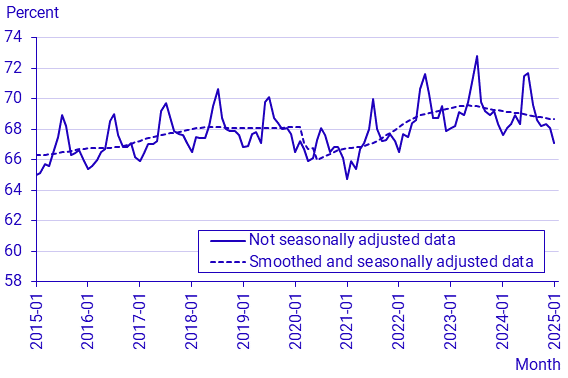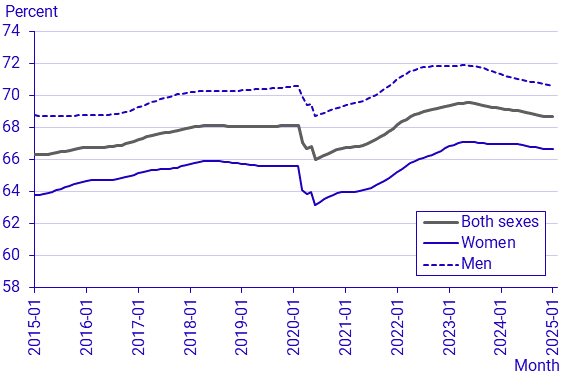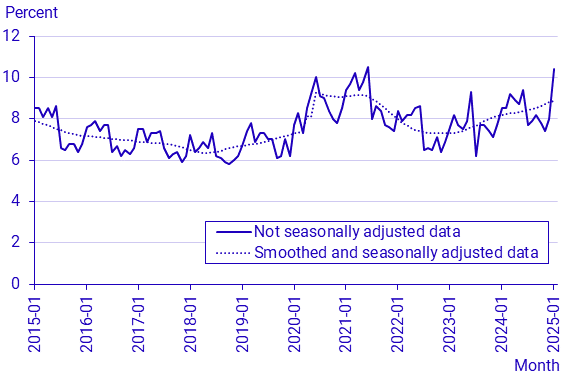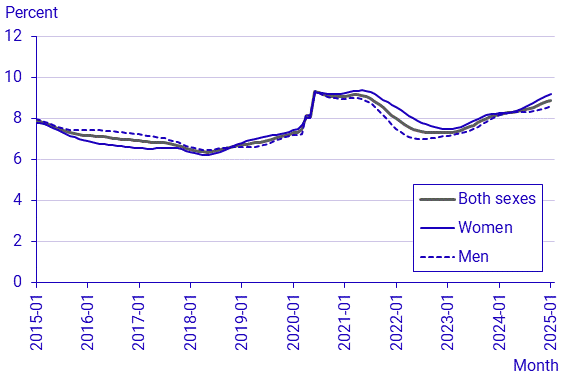Labour Force Surveys (LFS), January 2025
Unemployment is increasing
Statistical news from Statistics Sweden 2025-02-17 8.00
In January 2025, the number of employed people amounted to 5 109 000, not seasonally adjusted. The average number of hours worked per week was 137.0 million. The number of unemployed people increased by 114 000 to 592 000. This corresponds to an unemployment rate of 10.4 percent, an increase of 1.9 percentage points. According to seasonally adjusted and smoothed data, the employment rate was 68.7 percent. Both the number and the share of unemployed people increased, seasonally adjusted and smoothed. The unemployment rate amounted to 8.9 percent.
The change in the number of unemployed between January 2024 and 2025 may be overestimated as the unemployment rate was at a relatively low level in the LFS January 2024. In order to determine whether the size of the change is permanent, further measurements are required. The LFS is a sample survey associated with uncertainty, which in some cases may lead to deviations in the estimates. The results for the LFS January 2025 should therefore be used with some caution.
– Unemployment increased in January. At the same time, we see a decrease in the number of women outside the labour force, says Charlotta Olofsson, statistician at the Labor Force Surveys at Statistics Sweden.
Labour force
In January 2025, the number of people in the labour force aged 15–74 amounted to 5 701 000, not seasonally adjusted, an increase of 87 000 people compared to the corresponding month previous year. The number of women in the labour force was 2 745 000, which is an increase of 86 000 people. The number of men amounted to 2 956 000. The labour force participation rate amounted to 74.8 percent. For women the labour force participation rate was 73.2 percent, an increase of 1.9 percentage points. For men it was 76.4 percent.
Seasonally adjusted and smoothed data show an increase in both the number and the share of people in the labour force, compared with recent months. The number of people in the labour force amounted to 5 741 000, which corresponds to a labour force participation rate of 75.4 percent.
Employment
The number of employed people aged 15-74 amounted to 5 109 000 in January 2025, not seasonally adjusted. The number of employed women was 2 453 000 and the number of employed men was 2 656 000. The employment rate amounted to 67.1 percent. The employment rate among women was 65.4 percent, and for men it was 68.7 percent.
The number of employed people aged 15–74 amounted to 5 231 000, seasonally adjusted and smoothed. This corresponds to an employment rate of 68.7 percent.
Employees
In January 2025, the number of employees amounted to 4 650 000, according to not seasonally adjusted data. The number of employees among women was 2 309 000. The number of employees among men was 2 341 000. The number of permanent employees amounted to 4 139 000. The number of permanent employees among women was 2 025 000, an increase of 73 000, and the number of permanent employees among men was 2 115 000. The number of temporary employees amounted to 511 000. Among women the number of temporary employees was 284 000 and for men it was 227 000.
The number of employees amounted to 4 739 000 according to seasonally adjusted and smoothed data, of which 4 114 000 were permanent employees and 625 000 were temporary employees. Compared with recent months, the number of permanent employees increased.
Hours worked
The average number of total hours worked in January 2025 amounted to 137.0 million per week, according to not seasonally adjusted data.
Seasonally adjusted and smoothed data show an increase in the number of hours worked compared with recent months. The average number of hours worked amounted to 155.6 million per week.
Unemployment
In January 2025, the number of unemployed people aged 15–74 amounted to 592 000, not seasonally adjusted, an increase of 114 000 people compared to the corresponding month previous year. This corresponds to an unemployment rate of 10.4 percent, an increase of 1.9 percentage points. The number of unemployed women increased by 64 000 and amounted to 292 000. The number of unemployed men was 300 000, which is an increase of 49 000 people. The unemployment rate amounted to 10.6 percent for women, an increase of 2.0 percentage points. For men it was 10.2 percent, which is an increase of 1.7 percentage points. The number of long-term unemployed people, unemployed for at least 27 weeks, amounted to 173 000. The number of long-term unemployed women was 73 000 and the number of long-term unemployed men was 100 000. The number of unemployed young people aged 15–24 amounted to 180 000 and the youth unemployment rate was 28.6 percent. Among unemployed young people, 113 000 were full-time students.
Compared with recent months, the number of unemployed people aged 15-74 increased to 510 000, according to seasonally adjusted and smoothed data. The unemployment rate also increased and amounted to 8.9 percent. Among young people aged 15–24 the number of unemployed amounted to 170 000 and the unemployment rate was 24.7 percent. Compared with recent months, this is an increase in both the number and the share of unemployed young people.
Unused labour supply
Unemployed people, underemployed people and latent jobseekers together constitute the unused labour supply. In January 2025, the unused labour supply averaged 27.4 million hours per week. This is an increase of 4.3 million hours compared to the corresponding month one year ago. The unused labour supply corresponds to 685 000 full-time employments with 40-hour work weeks.
People outside the labour force
In January 2025, the number of people not in the labour force aged 15–74 amounted to 1 918 000, not seasonally adjusted. The number of women not in the labour force was 1 006 000, which is a decrease of 68 000 people compared to the corresponding month previous year. The number of men amounted to 912 000.
Seasonally adjusted and smoothed data show a decrease in both the number and the share of people not in the labour force, compared with recent months. The number of people not in the labour force amounted to 1 877 000, which corresponds 24.6 percent of the population.

Source: Statistics Sweden

Source: Statistics Sweden

Source: Statistics Sweden

Source: Statistics Sweden
Next publishing will be
2025-02-25, kl. 08:00.
Feel free to use the facts from this statistical news but remember to state Source: Statistics Sweden.
